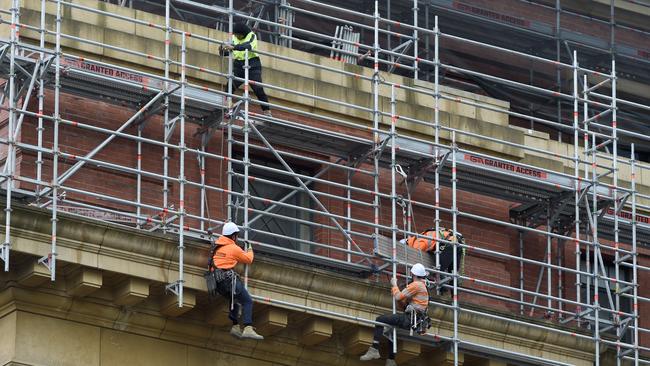Builders fear a multi-billion dollar infrastructure boom to deepen skilled workers crisis
Builders say a multi-billion dollar surge in infrastructure projects will only deepen the current crisis of skilled workers in the construction sector.
There are fears hundreds of billions dollars worth of looming public infrastructure projects will deepen an already severe shortfall of skilled labour in the construction sector.
Over the last few years the construction sector has taken the brunt of a confluence of factors which created the so-called profitless boom that sparked a surge in insolvencies including a string of well known company collapses.
Last year the total share of construction sector administration appointments reached 33 per cent of all company collapses – well above historic highs – as the sector started to slow after a period of surging demand sparked by low interest rates, first homeowner and HomeBuilder grants in the residential sector.
While some of the issues behind the profitless boom such as rampant material cost increases and supply chain issues have settled, demand for skilled labour has never been higher with a long list of infrastructure projects around the country forecast to suck up skilled tradies.
According to Infrastructure Australia, there is a major public infrastructure pipeline valued at $230bn over five years while at the same there is a target of building 1.2 million new homes as well as major investment in the energy sector. It said Australia’s infrastructure workforce will need to grow by 127 per cent to meet demand.
Michael McNab, managing director and founder of the diversified South East Queensland builder McNab, said while the rise in construction costs and supply chain issues have “settled down” he was concerned over the ambitiously high public infrastructure rollout.
“The infrastructure rollout for the next three or four years is huge. They are amazing numbers and it preys at the back of my mind,” he said.
“Hospital rollouts, transport, the Olympics, renewables – we have every sector firing at the same time. It’s fantastic but it’s going to put a strain things.
“Labour is still difficult and we do need more skilled migration. It’s basic supply and demand means prices go up but it also means that productivity goes down. One of the big issues is productivity that’s a real battle and it’s not an easy one.”

Mr McNab, whose family company has about 500 staff and is currently working on 40 projects, believes skilled labour migration will play a role in any solution.
“We have a lot of apprentices and the industry on balance could still do more with training but we need an influx now. We can’t wait three to five years,” he said.
“As a business we’re very selective about what we build. We don’t want to commit to certain projects because of the labour supply issue. We’ve had to change. We’ve had to become more diversified. This is a time when you’ve never had to be more on your game.”
Infrastructure Australia’s 2023 Infrastructure Market Capacity report found that the country’s
infrastructure, housing and energy agenda was under threat amid challenges accessing local building materials and a shortfall of 229,000 public infrastructure workers.
The report found that while the sector was finding it increasingly difficult to source key building materials it is had difficulty finding skilled workers, particularly engineers, skilled trades and labourers.
Richlister and developer Kevin Seymour, who has been in the property game for six decades, said conditions in the construction sector have never been worse.
“I have never seen the building side in such a bad way. This is the worst I’ve seen in my entire life,” he said.
“The problem they have is that there are no resources there. There is a real big risk of not having the ability to create all of this infrastructure. And how do you build all of these houses?”

According to the annual BCI Construction Outlook report 90 per cent of builders surveyed identified labour shortages as a key risk to their business, adding to the uncertainty of their on-site work scheduling and potentially causing developers to shelve projects.
The Bureau of Statistics figures for January found the number of loans issued for the purchase and construction of new homes fell by 4.2 per cent and remains at its lowest level since 2008.
Hutchinson Builders executive chairman Scott Hutchinson said a lack of subcontractors was the main problem at the moment, which has impacted on productivity for one of Australia’s largest apartment builder.
“For us it’s been the apartment boom on the Gold Coast which has sucked up all the subcontractors,” he said.
“Many of the subcontractors have gone broke and we’re doing our own formwork ceilings and partitions. It’s all to do with demand down there and I think that’s now starting to settle.”
Andrew Spring, a partner at recovery, corporate and personal insolvency experts Jirsch Sutherland, said the construction sector has always been over-represented in the ratio of insolvencies across Australia.
He said the construction sector was “hit hard and hit early” in the wake of the covid pandemic.
“I think the turmoil over the last few years has been addressed in terms of the uncertainty,” he said.
“At the moment governments are still combating an inflationary environment so do they really want to add fuel to the fire by doing a lot of public works. It will be challenging and people are still working from the position they have found themselves in the last few years. It’s still going to be difficult.”

Mr Spring said historically the construction sector took up about 25 per cent of all insolvencies which is due to the way the industry is structured.
“A lot of small business need to be incorporated in order to operate in that space. A lot of sub contractors are forced to go into a corporate structure to and avoid litigation and rulings.”
Subbies United spokesman John Goddard said the construction industry was a “mess” with late payment, non payment and non payment of retentions to subbies common place.
“We have a very large number of builders and they are pretty much all doing the same thing which includes but not limited to non payment, late payment and no payment at all,” he said.
Mr Goddard said if there is no written contract, the Queensland Building and Construction Commission (QBCC) would not act against the builder even if a subcontractor had lodged a complaint over money owed.
“In some cases, if subbies don’t have a written contract, they don’t get paid despite implied contracts such as texts from the builder saying ‘happy with your quote, please proceed,” he said.
“That is an implied contract but with the QBCC not capable of dealing with that one builder has made an art form of this rort. All this means one thing, these builders are trading insolvent.”





To join the conversation, please log in. Don't have an account? Register
Join the conversation, you are commenting as Logout